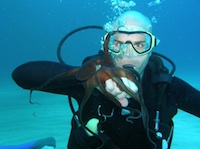Full STEAM Ahead
Thanks for attending! Workshop resources are available for download by clicking here.
Projects & Resources
Crocheted Reef & Anemone Garden
Seventh grade students crocheted a 400 organism coral reef, which they then used to teach younger students about biodiversity, reef relationships, and environmental stewardship.
Resource: The Hyperbolic Reef, http://crochetcoralreef.org
Microscope Art
Students used digital microscope cameras to take photographs of everyday objects at 1x, 50x, 100x, and 200x. They created collages of their images and wrote artist’s statements that communicated their scientific understanding.
Resource: STR Digital Microscopes, http://www.schooltr.com
Camouflaged Butterflies
Students created pairs of butterflies that would blend into our science classroom. They created one butterfly for a specific location, and a second that they then had to find a place for in the room.
Cell Project 2.0
In a revamping of the classic cell model project, students designed cell models that show functions of each organelle. For example, in a United States of America-themed cell, border guards represent the cell membrane because they control what goes in and out of the country, just like the cell membrane regulates what goes in and out a cell.
Resource: Full project instructions & student materials on my website, http://www.thescienceguru.com
ExploraVision Project
As part of a the NSTA/Toshiba ExploraVision project, students designed technologies for 20 years into the future. As an extension to the project, students created 2-D and 3-D models of their technologies that communicate their ideas and design process.
Resources: ExploraVision website, http://www.exploravision.org, TinkerCad, http://www.tinkercad.com
Scientific Sketching
Whether drafting a lab procedure, taking notes during a class discussion, or communicating a solution to a problem, annotated sketches allow students to communicate ideas, process, and understanding.
Sink & Float
As a culminating activity in our density unit, students designed submarine vehicles that sink to the bottom of the “ocean,” retrieve an object, and return to the surface on command.
Resources: The Tech Museum, http://www.thetech.org/educator-resources/design-challenge-lessons
Da Vinci Inventions
In collaboration with the 6th grade history teacher, students researched a Renaissance Invention, created a 2-D or 3-D model of the invention, and reimagined it as a technology of the future.

